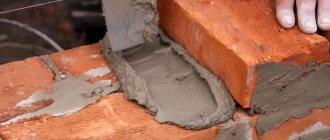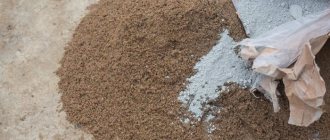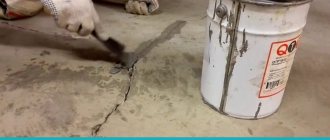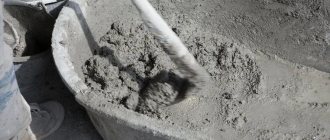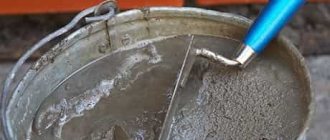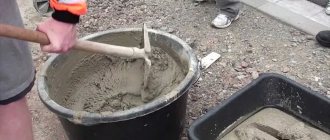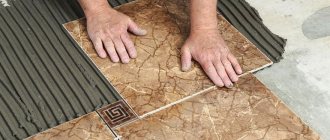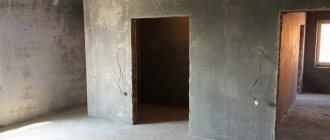Cement mortar is widely used in construction and renovation. It is used for the construction of brickwork, when laying the foundation, internal and external finishing work. No home renovation is complete without cement mortar - it is needed for plastering walls, leveling floors, and laying ceramic tiles.
The technique for making the solution is quite simple - any novice repairman can mix the components. In this material we will figure out how to make cement with your own hands with a small set of tools.
In construction, cement mortar is used when laying foundations, erecting brick walls, and is used in the process of external and internal finishing work.
Review of concrete brands
The grade of concrete is the main indicator of its strength. The higher the numerical number of concrete, the more reliable and durable the finished composition will be.
- M50–75 is a lightweight version of cement mortar, used in interior finishing work, for floor screed and as a grout for brickwork;
- M100–150 – the so-called “lean concrete”, used as a floor screed, in the manufacture of paths and curbs and in auxiliary work during construction;
- M200 – mortar for brickwork, screed and plaster for interior and exterior work;
- M300 is a durable composition, used mainly in street construction.
To make a cement mortar of the required strength, it is not necessary to buy concrete of the appropriate grade. In the process of preparing the mixture, concrete is mixed with sand, changing the proportion. Thus, from M400 grade raw materials you can easily obtain a cement mixture M100 or M200.
High-grade cement mortar is used for exterior work, as well as for finishing especially protected buildings. You should not use it at home, since such cement weighs a lot and has a pronounced texture.
The most common grades of concrete for preparing mortar are M400 and M500. From them you can obtain a cement mixture for both finishing and minor construction work.
Cleaned sand
Sand is a structural filler that reduces the cost of the solution and forms its frame. A high-quality filler increases the plasticity and strength of the mixture, corrects its shrinkage and prevents the formation of cracks in the cement sheet.
Sand is selected taking into account the technical requirements for the solution:
- purified river sand is suitable for plastering work;
- for masonry – fine quartz filler;
- for the preparation of concrete solutions - dry, purified material of any fraction.
When making plastering and finishing mixtures, sand is replaced with gypsum. It has a powdery texture and adheres well to surfaces.
Necessary materials and tools for work
Its strength, technical and visual characteristics depend on the composition of the cement solution. The standard composition of the mixture consists of three elements:
- dry cement;
- sand;
- water.
In order to change the qualities of the composition, the following additives are used:
- detergent;
- PVA glue;
- lime;
- dyes.
They affect the color of the coating and help make it more flexible and adhesive.
In order to mix and lay the cement mortar, you will need the following tools:
- a bucket or deep basin for stirring, corresponding in size to the volume of the mixture;
- construction mixer or drill with an attachment;
- spatula or spatula for spreading the mixture over the surface;
- gloves and glasses for safety purposes.
All these tools will probably be found in the households of people who have at least once done repairs. Otherwise, you should buy them or borrow them from friends.
A construction mixer or a drill attachment will help stir the mixture without lumps. The composition will be homogeneous and there will be no voids left in it after hardening.
For pouring wide surfaces, it is recommended to use a concrete mixer. It will significantly reduce the time of mixing the solution and help calculate proportions for a large volume of material.
Types of solution
The type of cement mortar varies depending on the brand of cement, the composition of the components and the presence of plasticizer additives. Based on the composition, two types of mortar can be distinguished - using lime and sand. Let's consider the properties of each of them.
In the process of home renovation, it is recommended to first make a dry mixture and only then dilute it with water to the desired consistency. There should not be a lot of moisture in the composition - it takes up approximately half of the total volume of the solution.
Cement-lime
Cement mortar with the addition of lime is characterized by plasticity and adhesion, therefore it is most often used in plaster or when laying tiles.
The mixture contains cement, lime and sand in proportions of 1:1:6 and 1:2:9 parts, respectively. To improve the plasticity and stickiness of the solution, PVA glue, detergents, and clay sand are added to it.
If quicklime is used, it should be quenched by mixing it with water. The chemical reaction generates a lot of heat, so you need to protect your hands and face when working with lime.
Lime in the composition allows you to lighten the cement mortar and make it more plastic. Therefore, it is often added when decorating walls indoors.
Cement-sand
Cement-sand mortar is the easiest coating option to manufacture. To mix it, take one part of cement to 6 or more parts of sand. The composition is suitable for street and rough work indoors. Since it does not have additional additives, its plasticity and adhesion do not allow the solution to be used for small plastering and tiling work.
Liquid soap and PVA glue are used as plasticizers that improve the adhesiveness and elasticity of the material. Clay or quarry sand helps to make the composition more plastic. To lighten and improve adhesion, builders add slaked lime to the mixture, producing a cement-lime mortar.
Sand is the main component in any cement mortar. Its share in the composition is several times higher than the content of concrete, water and plasticizer additives.
Additives for colored seams
Color additives in the cement mixture serve purely decorative purposes. They are most often used when laying bricks to make the seams more expressive and aesthetically pleasing.
Carbon black was previously used to impart a dark color, but experience has shown that this component worsens the technical characteristics of cement. Today, metal salts and oxides are used for these purposes. Color additives can be purchased at hardware stores.
Question:
How to make seams white?
Answer:
The easiest way to achieve white joints is by increasing the amount of lime in the solution. However, you can purchase a special tinting mixture with titanium oxide or other metals.
It is customary to make masonry seams contrasting with the shade of the brick. For buildings made of red brick, white grout is used, for light-colored materials - gray or black.
Cement dyes are available in the form of powder or liquid paint. They are added to the mixture during its preparation and mixed thoroughly with other ingredients.
How cement is prepared in production
The main substances from which cement is produced are limestone and clay. From these two components, clinker is prepared in a special way, which is subsequently mixed with other additives that determine the quality, brand and properties of the solution. Mandatory additives include: gypsum, dolomite, cementite.
Stages of cement production.
In nature there is clinker in its pure form - marl, but due to the small reserves of this mineral, it is not possible to use it on an industrial scale, so domestic and foreign manufacturers prepare clinker from traditional materials.
Marl.
Cement production is divided into the following stages:
- To prepare clinker, you need to thoroughly mix the ingredients in special large-capacity drums.
- At the next stage, the prepared mass enters the oven, where firing occurs for 3-4 hours at a temperature close to one and a half thousand degrees. As a result, clinker is formed in the form of small fractions (up to 5 cm in diameter).
Sludge roasting.
- Next, the resulting clinker grains are crushed in drums using ball screens. During the processing of the material, it is necessary to achieve a powdery state of the mixture.
- At the final stage, the necessary additives are added to the finished cement and sent for packaging in bags or hoppers.
There are three ways to make cement. They differ in clinker processing techniques.
- Wet method. Clinker is produced using water, chalk and clay. As a result of mixing substances in the drum, a wet mass is formed - a charge. It is sent for firing, after which the resulting granules are crushed and mixed with the necessary additives. This method is considered quite expensive, so other methods are now more often used.
- Dry method. Allows you to shorten the stage of mixing the finished mixture with additives, since the whole process comes down to preparing, crushing and mixing ready-made ingredients. This technology is becoming increasingly popular, as it can significantly reduce production costs and the final price of the product.
- Combined method. This technology uses various forms of clinker production, combining the production steps used in dry and wet methods.
Mixing proportions
The ratio of elements in the cement mortar depends on the area of application of the mixture and the brand of concrete. For example, if you need to get M100 cement mortar from M400 concrete, the ratio of cement to sand will be 1:4. Thus, it is easy to calculate what ratio is needed to obtain the desired grade from any concrete.
How to make cement mortar for different types of work (cement: sand):
- Plaster: 1:5 with the addition of one part of lime;
- Floor screed: 1:4 for brand M500, 1:3 for brand M400;
- Brickwork: 1:5 – M3, 1:4 – M5, 1:3 – M8. In this case, the brand of the finished mortar must correspond to the brand of brick.
The volume of water for preparing the liquid solution should not exceed 60% of the total volume. Usually it is 1-2 parts in proportion.
During the mixing process, the cement mortar sometimes becomes too liquid. Set aside some of the dry mixture so you can add it if necessary.
How to make cement at home
First of all, you should immediately understand that it will not be possible to obtain a high-quality product at home or in the garage. It’s not enough to know how to make cement yourself, because in addition to this you will need to purchase special equipment, or make maximum muscular efforts, which ultimately turns out to be quite costly and tedious. It is much easier to purchase a finished product in a store.
The easiest way to obtain a solution at home suitable for cementing small cracks is to prepare a mixture based on the following ingredients: water, aqueous lime and stone ash. These substances are mixed until a homogeneous, viscous mass is obtained, which must be used immediately, since the shelf life of this solution is no more than two hours.
Other options for making cement yourself include a kiln for firing the material and a mill for grinding clinker into powder.
Drying time
The hardening time of the cement mortar directly depends on the ambient temperature and the thickness of the coating. The thicker the screed layer and the lower the thermometer, the longer the mixture will take to dry.
Let's consider the hardening time under favorable conditions:
- 2–4 hours – setting of the solution;
- 12–24 hours – the cement has not completely hardened, you can walk on it, but finishing work is not recommended;
- 10–14 days – complete drying of the coating, after which you can begin finishing the surface with tiles or other materials.
The hardening conditions are easiest to observe indoors – when screeding floors, plastering and other finishing works. There are no temperature changes in the apartment, so the solution hardens evenly and quickly.
How to prepare cement at low temperature
The ideal temperature for pouring cement mortar is +200C and above. But such conditions are not always possible to create during the construction and exterior decoration of a building. At sub-zero temperatures, the concrete solution forms lumps, and the water in the composition turns into ice. This directly affects the quality of the coating.
In construction, there are several techniques that help avoid damage to the cement mixture at sub-zero temperatures:
- Special antifreeze additives in the composition;
- Heating water and sand when mixing concrete;
- Electric heating of the coating;
- Covering the fill with an awning and insulating the formwork.
For masonry at sub-zero temperatures (up to -7°C), you need to use cement mortar (in the ratio of cement to sand - 1:4) or cement-calcium (1:1:6 - cement, calcium, sand). The solution should be thickly plastic, that is, contain a small amount of water.
It is very difficult to make electric heating of concrete with your own hands. To do this, heated electrical cables are brought to the surface, which transfer heat to the concrete coating.
The easiest way to insulate the cement surface outdoors is with a stretched awning. This design will retain heat in light frosts.
The use of concrete in home decoration
In the interior decoration of apartments and houses, concrete is used in three types of work:
- plastering walls;
- pouring floor screed;
- installation of ceramic tiles in the bathroom.
The solution for home finishing must be sufficiently plastic and have good adhesion to the rough coating. Therefore, plasticizers and adhesive additives must be added to it.
Ready-made adhesive is often used to lay tiles in the bathroom, but cement mortar is also well suited for these purposes. It is important to take care of the waterproofing of the floor and the presence of antifungal compounds in the finished mixture.
Floor screed
Cement-sand mortars with proportions of 1:4 (cement-M400) are suitable for pouring floor coverings. In residential buildings, compositions made from 1 part Portland cement and 3 parts purified sand are used.
Plasticizers and polypropylene fibers reduce plastic shrinkage of coatings and prevent their deformation and cracking. In this regard, builders recommend adding about 50 ml of dishwashing detergent or special additives to 100 liters of solution.
Useful tips
- Select a deep container for the solution so that when stirring it does not splash out over the walls;
- Instead of mortar, special grouts can be used to treat the seams of bricks or tiles; in this case, cement dyes will not be required;
- A day after screeding the floor, cover it with film so that the coating is not damaged during the repair process.
To prepare the mixture, it is recommended to use river or quarry sand. Due to the clay content in its composition, the solution will be more plastic and sticky.
